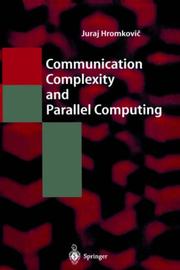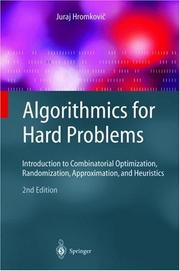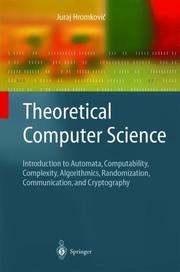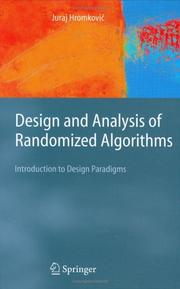| Listing 1 - 10 of 32 | << page >> |
Sort by
|

ISBN: 354057459X 3642081851 3662034425 Year: 1997 Publisher: Berlin Springer
Abstract | Keywords | Export | Availability | Bookmark
 Loading...
Loading...Choose an application
- Reference Manager
- EndNote
- RefWorks (Direct export to RefWorks)
The communication complexity of two-party protocols is an only 15 years old complexity measure, but it is already considered to be one of the fundamen tal complexity measures of recent complexity theory. Similarly to Kolmogorov complexity in the theory of sequential computations, communication complex ity is used as a method for the study of the complexity of concrete computing problems in parallel information processing. Especially, it is applied to prove lower bounds that say what computer resources (time, hardware, memory size) are necessary to compute the given task. Besides the estimation of the compu tational difficulty of computing problems the proved lower bounds are useful for proving the optimality of algorithms that are already designed. In some cases the knowledge about the communication complexity of a given problem may be even helpful in searching for efficient algorithms to this problem. The study of communication complexity becomes a well-defined indepen dent area of complexity theory. In addition to a strong relation to several funda mental complexity measures (and so to several fundamental problems of com plexity theory) communication complexity has contributed to the study and to the understanding of the nature of determinism, nondeterminism, and random ness in algorithmics. There already exists a non-trivial mathematical machinery to handle the communication complexity of concrete computing problems, which gives a hope that the approach based on communication complexity will be in strumental in the study of several central open problems of recent complexity theory.
Mathematical control systems --- Computer science --- Computational complexity. --- Parallel processing (Electronic computers) --- Parallel processing (Electronic computers). --- Architecture, Computer. --- Computers. --- Computer communication systems. --- Input-output equipment (Computers). --- Electrical engineering. --- Mathematical logic. --- Computer System Implementation. --- Theory of Computation. --- Computer Communication Networks. --- Input/Output and Data Communications. --- Communications Engineering, Networks. --- Mathematical Logic and Formal Languages. --- Algebra of logic --- Logic, Universal --- Mathematical logic --- Symbolic and mathematical logic --- Symbolic logic --- Mathematics --- Algebra, Abstract --- Metamathematics --- Set theory --- Syllogism --- Electric engineering --- Engineering --- Computer hardware --- Computer I/O equipment --- Computers --- Electronic analog computers --- Electronic digital computers --- Hardware, Computer --- I/O equipment (Computers) --- Input equipment (Computers) --- Input-output equipment (Computers) --- Output equipment (Computers) --- Computer systems --- Communication systems, Computer --- Computer communication systems --- Data networks, Computer --- ECNs (Electronic communication networks) --- Electronic communication networks --- Networks, Computer --- Teleprocessing networks --- Data transmission systems --- Digital communications --- Electronic systems --- Information networks --- Telecommunication --- Cyberinfrastructure --- Electronic data processing --- Network computers --- Automatic computers --- Automatic data processors --- Computing machines (Computers) --- Electronic brains --- Electronic calculating-machines --- Electronic computers --- Cybernetics --- Machine theory --- Calculators --- Cyberspace --- Architecture, Computer --- Input-output equipment --- Distributed processing --- High performance computing --- Multiprocessors --- Parallel programming (Computer science) --- Supercomputers

ISBN: 3540441344 9783540441342 Year: 2004 Publisher: Berlin Springer
Abstract | Keywords | Export | Availability | Bookmark
 Loading...
Loading...Choose an application
- Reference Manager
- EndNote
- RefWorks (Direct export to RefWorks)
Computer science --- Numerical approximation theory --- Numerical methods of optimisation --- Discrete mathematics --- Informatique --- Computer science. --- Algorithmique --- Algorithmes --- Complexite

ISBN: 3540140158 9783540140153 Year: 2004 Publisher: Berlin: Springer,
Abstract | Keywords | Export | Availability | Bookmark
 Loading...
Loading...Choose an application
- Reference Manager
- EndNote
- RefWorks (Direct export to RefWorks)
cryptografie --- Computer science --- Computer Science. --- Informatique --- Computer science. --- Cryptographie --- Algorithmique --- Automates abstraits --- Complexite

ISBN: 3540279032 3540239499 3642063004 9783540239499 Year: 2005 Publisher: Berlin Springer
Abstract | Keywords | Export | Availability | Bookmark
 Loading...
Loading...Choose an application
- Reference Manager
- EndNote
- RefWorks (Direct export to RefWorks)
Randomness is a powerful phenomenon that can be harnessed to solve various problems in all areas of computer science. Randomized algorithms are often more efficient, simpler and, surprisingly, also more reliable than their deterministic counterparts. Computing tasks exist that require billions of years of computer work when solved using the fastest known deterministic algorithms, but they can be solved using randomized algorithms in a few minutes with negligible error probabilities. Introducing the fascinating world of randomness, this book systematically teaches the main algorithm design paradigms – foiling an adversary, abundance of witnesses, fingerprinting, amplification, and random sampling, etc. – while also providing a deep insight into the nature of success in randomization. Taking sufficient time to present motivations and to develop the reader's intuition, while being rigorous throughout, this text is a very effective and efficient introduction to this exciting field.
Stochastic processes. --- Algorithms. --- Algorism --- Algebra --- Arithmetic --- Foundations --- Random processes --- Probabilities --- Computer science --- Computer science. --- Computer software. --- Computational complexity. --- Programming Techniques. --- Algorithm Analysis and Problem Complexity. --- Computation by Abstract Devices. --- Discrete Mathematics in Computer Science. --- Complexity, Computational --- Electronic data processing --- Machine theory --- Software, Computer --- Computer systems --- Informatics --- Science --- Computer programming. --- Computers. --- Computer science—Mathematics. --- Automatic computers --- Automatic data processors --- Computer hardware --- Computing machines (Computers) --- Electronic brains --- Electronic calculating-machines --- Electronic computers --- Hardware, Computer --- Cybernetics --- Calculators --- Cyberspace --- Computers --- Electronic computer programming --- Electronic digital computers --- Programming (Electronic computers) --- Coding theory --- Programming
Book
ISBN: 3642426069 3540859853 9786612331756 1282331752 3540859861 Year: 2009 Publisher: Berlin ; London : Springer,
Abstract | Keywords | Export | Availability | Bookmark
 Loading...
Loading...Choose an application
- Reference Manager
- EndNote
- RefWorks (Direct export to RefWorks)
The ?rst and foremost goal of this lecture series was to show the beauty, depth and usefulness of the key ideas in computer science. While working on the lecture notes, we came to understand that one can recognize the true spirit of a scienti?c discipline only by viewing its contributions in the framework of science as a whole. We present computer science here as a fundamental science that, interacting with other scienti?c disciplines, changed and changes our view on the world, that contributes to our understanding of the fundamental concepts of science and that sheds new light on and brings new meaning to several of these concepts. We show that computer science is a discipline that discovers spectacular, unexpected facts, that ?nds ways out in seemingly unsolvable s- uations, and that can do true wonders. The message of this book is that computer science is a fascinating research area with a big impact on the real world, full of spectacular ideas and great ch- lenges. It is an integral part of science and engineering with an above-average dynamic over the last 30 years and a high degree of interdisciplinarity. The goal of this book is not typical for popular science writing, whichoftenrestrictsitselftooutliningtheimportanceofaresearch area. Whenever possible we strive to bring full understanding of the concepts and results presented.
Computer algorithms. --- Computer algorithms --- Engineering & Applied Sciences --- Computer Science --- Algorithms. --- Algorism --- Computer science. --- Software engineering. --- Computers. --- Education --- Popular works. --- Computer Science. --- Software Engineering/Programming and Operating Systems. --- Computers and Education. --- Algorithm Analysis and Problem Complexity. --- Popular Science, general. --- Computing Methodologies. --- Theory of Computation. --- Data processing. --- Algebra --- Arithmetic --- Foundations --- Algorithms --- Education. --- Computer software. --- Science (General). --- Artificial intelligence. --- Information theory. --- Artificial Intelligence. --- Communication theory --- Communication --- Cybernetics --- AI (Artificial intelligence) --- Artificial thinking --- Electronic brains --- Intellectronics --- Intelligence, Artificial --- Intelligent machines --- Machine intelligence --- Thinking, Artificial --- Bionics --- Cognitive science --- Digital computer simulation --- Electronic data processing --- Logic machines --- Machine theory --- Self-organizing systems --- Simulation methods --- Fifth generation computers --- Neural computers --- Software, Computer --- Computer systems --- Children --- Education, Primitive --- Education of children --- Human resource development --- Instruction --- Pedagogy --- Schooling --- Students --- Youth --- Civilization --- Learning and scholarship --- Mental discipline --- Schools --- Teaching --- Training --- Computer software engineering --- Engineering --- Education—Data processing. --- Automatic computers --- Automatic data processors --- Computer hardware --- Computing machines (Computers) --- Electronic calculating-machines --- Electronic computers --- Hardware, Computer --- Calculators --- Cyberspace
Digital
ISBN: 9783540279037 Year: 2005 Publisher: Berlin, Heidelberg Springer-Verlag Berlin Heidelberg
Abstract | Keywords | Export | Availability | Bookmark
 Loading...
Loading...Choose an application
- Reference Manager
- EndNote
- RefWorks (Direct export to RefWorks)
Complex analysis --- Discrete mathematics --- Computer science --- discrete wiskunde --- complexe analyse (wiskunde) --- informatica --- algoritmen
Digital
ISBN: 9783540859864 Year: 2009 Publisher: Berlin, Heidelberg Springer-Verlag Berlin Heidelberg
Abstract | Keywords | Export | Availability | Bookmark
 Loading...
Loading...Choose an application
- Reference Manager
- EndNote
- RefWorks (Direct export to RefWorks)
Science --- Computer assisted instruction --- Complex analysis --- Computer science --- Programming --- Information systems --- popularisering wetenschap --- toegepaste informatica --- complexe analyse (wiskunde) --- computerondersteund onderwijs --- wetenschappen --- systeemontwikkeling (informatica) --- methodologieën
Book
ISBN: 3835191152 Year: 2007 Publisher: Wiesbaden : Vieweg+Teubner Verlag : Imprint: Vieweg+Teubner Verlag,
Abstract | Keywords | Export | Availability | Bookmark
 Loading...
Loading...Choose an application
- Reference Manager
- EndNote
- RefWorks (Direct export to RefWorks)
Das Ziel dieses Buches ist es, den Leser an den Grundlagen der Informatik zu begeistern. Um dies zu erreichen, bieten wir außer der üblichen rigorosen und detaillierten Präsentation eine leicht verständliche und anschauliche Darstellung der Grundkonzepte und Ideen und erweitern die klassischen Themen wie Berechenbarkeit und Komplexität um die faszinierenden Errungenschaften neuer Gebiete wie Randomisierung, Kryptographie und Kommunikation in Netzen. Die vorliegende Auflage wurde durch ein Kapitel über Grammatiken und die Chomsky-Hierarchie erweitert.
Book
ISBN: 3834822663 Year: 2012 Publisher: Wiesbaden : Vieweg+Teubner Verlag : Imprint: Vieweg+Teubner Verlag,
Abstract | Keywords | Export | Availability | Bookmark
 Loading...
Loading...Choose an application
- Reference Manager
- EndNote
- RefWorks (Direct export to RefWorks)
Dieses Lehrbuch schließt eine große Lücke in den Unterrichtsmaterialien für das Lehramtsstudium und für die Informatik an Gymnasien. Die im Buch benutzte Programmierumgebung steht kostenfrei zur Verfügung. Ziel des Buches ist es insbesondere, ein tieferes Verständnis für die fundamentalen Konzepte des systematischen Programmierens zu wecken. Besonderer Wert wird auf eine sehr detallierte und anschauliche Darstellung gelegt. Der Inhalt: Programme als Folge von Befehlen - Einfache Schleifen - Programme benennen und aufrufen - Zeichnen von Kreisen und regelmäßigen Vielecken - Programme mit Parametern - Bewegte Bilder und Zeichentrickfilme - Übergabe von Parameterwerten an Unterprogramme - Optimierung der Programmlänge und der Berechnungskomplexität - Das Konzept von Variablen - Lokale und globale Variablen - Verzweigung von Programmen - Integrierter LOGO- und Mathematikunterricht: Geometrie und Gleichungen - Rekursion - Integrierter LOGO- und Mathematikunterricht: Trigonometrie - Integrierter LOGO- und Mathematikunterricht: Vektorgeometrie Die Zielgruppen Studierende des Lehramtsstudiengangs Informatik Studienanfänger Schüler Der Autor Prof. Dr. Juraj Hromkovic lehrt und forscht and der ETH Zürich. Seit 2010 ist er Mitglied der Academia Europaea.
Book
ISBN: 3658048328 Year: 2014 Publisher: Wiesbaden : Springer Fachmedien Wiesbaden : Imprint: Springer Vieweg,
Abstract | Keywords | Export | Availability | Bookmark
 Loading...
Loading...Choose an application
- Reference Manager
- EndNote
- RefWorks (Direct export to RefWorks)
Dieses Lehrbuch ermöglicht einen begeisterten Einstieg ins Programmieren ab 10 Jahren. Programmierunterricht wird dabei als Förderung der konstruktiven Lösungsfähigkeit und der exakten Kommunikation zur Steuerung eines Computers verstanden. Die Schüler entdecken und entwickeln die Programmiersprache selbstständig mit und lernen, Aufgaben systematisch zu lösen. Beginnend mit einzelnen Anweisungen werden einfache Programme spielerisch eingeführt. Das Buch zeichnet sich aus durch seine detaillierten Erklärungen und anschaulichen Darstellungen. Die Programmierumgebung sowie die Arbeitshefte für den Unterricht stehen kostenlos zum Download zur Verfügung. Der Inhalt Programme als Folge von Befehlen - Einfache Schleifen - Programme benennen und aufrufen - Zeichnen von Kreisen und regelmäßigen Vielecken - Programme mit Parametern - Bewegte Bilder und Zeichentrickfilme - Übergabe von Parameterwerten an Unterprogramme - Optimierung der Programmlänge und der Berechnungskomplexität - Das Konzept von Variablen - Lokale und globale Variablen - Verzweigung von Programmen - Rekursion - Integrierter LOGO- und Mathematikunterricht: Geometrie und Gleichungen, Trigonometrie, Vektorgeometrie Die Zielgruppen Alle Lehrpersonen Studierende des Lehramtsstudiengangs Informatik Alle Schülerinnen und Schüler ab 10 Jahren Der Autor Prof. Dr. Juraj Hromkovič lehrt und forscht an der ETH Zürich. Seit 2010 ist er Mitglied der Academia Europaea.
| Listing 1 - 10 of 32 | << page >> |
Sort by
|

 Search
Search Feedback
Feedback About UniCat
About UniCat  Help
Help News
News